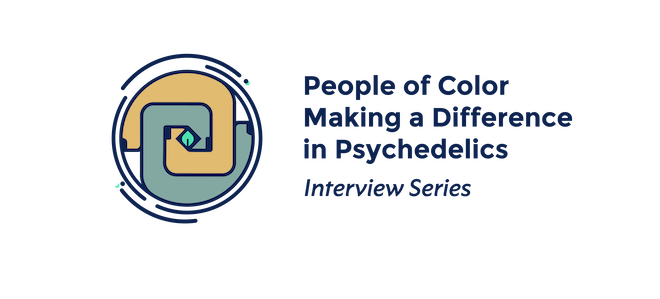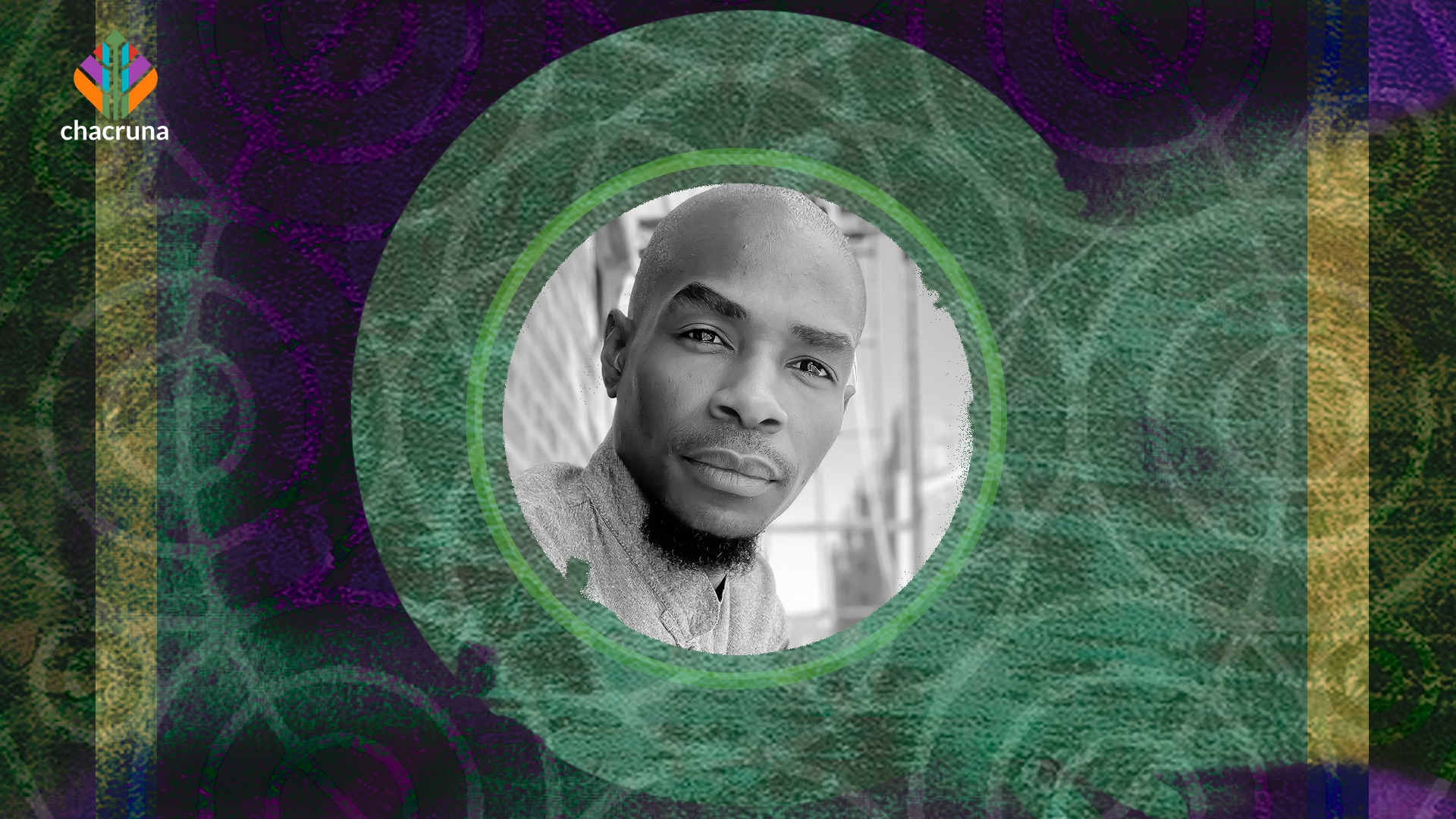- Entheogens, the African Diaspora, and BIPOC communities with Kufikiri Imara - January 20, 2021
- Innovating Native American Health Care Using Culture and Technology With Sutton King - January 11, 2021
- Navigating the Personal and Political in MDMA-assisted Psychotherapy with Sara Reed - December 29, 2020

Sensei Kevon Simpson is a two-spirit Jamaican spiritual healer known for his high-dose work and founding the Entheogen Integration Circle in NYC. Having come from a lineage of Jamaican healers, it was little surprise that Kevon showed a natural aptitude for spiritual work, which led him to pursue various disciplines such as karate, meditation, and later, the path of the curanderismo in the Amazon rainforest and Andes. His intent was to bring the sacred healing medicine of South America to marginalized communities.
As a medicine guide and high-dose solo sitter, Sensei Kevon Simpson is considered one of the leaders of the underground psychedelic renaissance. In this interview, we discuss his shamanic training, his experience as a Jamaican in the US, high-dose work, and bridging the gap between the psychedelic underground and aboveground.
Maria Mocerino: As a spiritual healer, how would you describe the work you do?
KS: I lead people through their traumatic and beautiful experiences through the use of entheogen compounds, meditation, dance, poetry, or other forms of artistic expression so that they can integrate them.
MM: How did you get into this kind of work?
KS: I come from a lineage of Jamaican spiritual healers. My mom was the first person that ever exposed me to something shamanic, before I even had the context or languaging for it. My great grandmother was also a healer that used plant medicines and ritual. This has been a part of how Jamaican people have survived. Although we had our own lineage of practices and our own ancestry, we were still a colonialized people. We were going to the church and Sunday school. In the church, I was being groomed to become a priest.
Later on in life, I answered the call to become a spiritual healer, not because of my upbringing being forced to practice Christianity, but because I came out of the closet. That world didn’t make sense to me, so I had to find my way in a world that I didn’t belong to, so I began researching meditation, brain wave states, and different cultures’ religious practices.
That led to taking karate class and becoming a black belt. In my dojo, I was first exposed to meditation through a book called Zen Mind, Beginners Mind by Shunryu Suzuki. Then, I sought out meditation centers to continue that pursuit in NYC but, usually, they were filled with people that did not look like me. They weren’t very welcoming, either. I went back into my cocoon and started practicing meditation on my own. I got into plant medicines when I realized that there were things inside of me that couldn’t be touched by meditation as fast as I wanted.
MM: Where are you from?
KS: I am from Kingston, Jamaica and Brooklyn, NYC. I grew up in both places, and now I live on the borderline of Brownsville. They have vastly different perspectives of oppression. Whereas in Crown Heights, it’s West Indian. In Brownsville, it’s more African-Americans. I found, growing up in Crown Heights and Flatbush, that I was able to hold onto my culture a bit more.
MM: Why exactly?
KS: I have generations of my lineage in an entirely different country that had its own independence, and there are a lot of people who look like me. In the United States, it is something else. An African-American is in a country where everyone doesn’t look like them, and they have also been disconnected from their roots. There is more amnesia to what your power can be. As a Jamaican, that’s not a hurdle for me.
I started the Entheogen Integration Circle when I realized how many people in NYC were having high-dose psychedelic experiences without a meditation practice.
MM: Why did you start the Entheogen Integration Circle?
KS: I started the Entheogen Integration Circle when I realized how many people in NYC were having high-dose psychedelic experiences without a meditation practice. I already had ten years of meditation under my belt. I was teaching mediation groups to adults and children in after-school programs.
In the psychedelic scene, I found people that had been ripped open on a plane of consciousness without any neurological programming in their brain to handle it. No one around them was able to tell them what was going on. I started Entheogen Integration Circle so that people could come in and get some tools and practices to integrate—not just their psychedelic experiences—but their experience of life itself. That’s what we’re really integrating.
MM: Let’s talk about high-dose work. We spoke about those who have done studies around high-dose work, such as Baba Kilindi Iyi. Can you give me a sense of what high-dose work has looked like?
KS: My experience is something that is still unfolding and evolving. There isn’t one way to do it, and it isn’t as limited as people would want to make it.
MM: I don’t understand that; what do you mean?
KS: In the clinical world, it’s the same thing. There are limits put in place that may or not be useful. The same happens in the underground scene and the high-dose work. My experience has been this. I did it incrementally. Terence McKenna said that the heroic dose was five grams, so I did that about ten years ago.
I had a deeply moving, awakening experience. A spirit reached through this plane to remind me that I came to Earth to become this medicine person that I am today. I had completely forgotten where my soul came from. In witnessing how much I had forgotten, however, I saw just how challenging it is to be human on this plane.
When I did the mushroom work in the shelter, in that not-so-perfect container, I was able to feel the multilayered ways that people oppress POC queer bodies. Needless to say, it wasn’t an easy journey to integrate.
I wouldn’t do close to ten grams until that experience I had of living in the shelter. I was at a societal rock bottom, imposed by a society in which my life didn’t matter. When I did the mushroom work in the shelter, in that not-so-perfect container, I was able to feel the multilayered ways that people oppress POC queer bodies. Needless to say, it wasn’t an easy journey to integrate.
MM: You recently did a dose of 22.22 grams; so, what happened?
KS: Ironically, it had enough nothing to do with the pandemic. It took me all the way back to childhood traumas around molestation from caregivers. We all have to clear our childhoods, what happened to us. I don’t know if confronting family members is always going to be the best route, because it could be met with so much resistance. You could be blamed for what happened to you. I think that it’s important to go into these sacred spaces with enough assistance to be able to navigate these really suppressed memories before they get problematic in our own relationships.
MM: Can you talk about the importance of intention, skill, and integration of high dose work?
KS: With plant medicines, people sometimes concentrate on the “far out” aspect of the experience: different planes, crystals, trans-dimensional this and that. I’m interested in how these experiences on other planes are useful on this plane. Sometimes, these journeys to alternate realities might not be the most useful thing for the current situation happening on planet Earth, unless we know how to dream through it, remember the dream, and fix it, so to speak. If we’re just visiting these planes without the skill and knowledge, we’re just plopping around in hyperspace.
MM: To start wrapping up, how does the “underground” connect with the “aboveground?” Can you talk about your experience dialoguing with the “mainstreaming” psychedelics movement?
KS: I think mainstreaming psychedelics is a great idea. They are systems busters. When consciousness is ready to shift, they do just that, especially the mushrooms. They flip everything on its head, that’s just what they do. I’m looking forward to doing that work on a cultural level with the commercialization of them.
What needs to happen is the dismantling of those two words: aboveground and underground. Keeping them separate allows clinical academics who are not as experienced to come in thinking that they are. You can’t be entering something with molecules and measurements thinking that you know more than people who can dream a new reality and dream onto this plane. They are practices that cannot be measured by science. Thus, these people carry an arrogance that is not conducive to creating harmony and changing the situation at hand.
MM: I’ve been thinking a lot about hubris lately. I feel like that’s what happening to the West, or at least, the US, right now.
KS: The hubris is immeasurable.
MM: It’s strange to me that medicine and healthcare would operate in this way. There are so many different medical systems, and some that are more effective than others. You would think that we would be working together, sharing knowledge. It’s a strange trait of the White conqueror.
KS: They won’t even come to our ceremonies and experience the thing that is bringing us together. If we’re not in ceremony together, then what are we doing? I did have a few clinical people come and I commended them for doing that because that took a huge leap from their White privileged world to come into the underground.
There is no human being on the planet whose ancestors haven’t done horrible things. No one wants to remember what their ancestors did, but we’re all here now. We’re tasked with unraveling it all, and it doesn’t feel like cotton candy and rainbows all the time.
MM: How do we affect change? How do we build bonds between people that weren’t ever there to begin with or have been brutally severed? It says a lot that they were able to sit in their discomfort, right?
KS: There is no human being on the planet whose ancestors haven’t done horrible things. No one wants to remember what their ancestors did, but we’re all here now. We’re tasked with unraveling it all, and it doesn’t feel like cotton candy and rainbows all the time. (laughter) Sometimes, in ceremonies, I’ll start singing “cotton candy and rainbows…” because you have to say some dumb shit sometimes. It gets too serious sometimes, so it’s not all “cotton candy and rainbows.” That’s what I always say.
Art by Mariom Luna.
Take a minute to browse our stock:
Did you enjoy reading this article?
Please support Chacruna's work by donating to us. We are an independent organization and we offer free education and advocacy for psychedelic plant medicines. We are a team of dedicated volunteers!
Can you help Chacruna advance cultural understanding around these substances?











